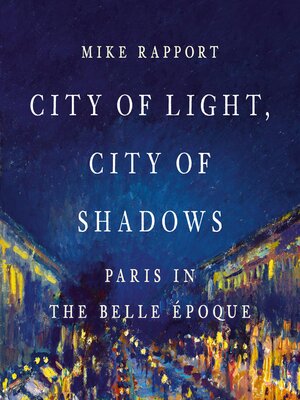
Sign up to save your library
With an OverDrive account, you can save your favorite libraries for at-a-glance information about availability. Find out more about OverDrive accounts.
Find this title in Libby, the library reading app by OverDrive.



Search for a digital library with this title
Title found at these libraries:
| Library Name | Distance |
|---|---|
| Loading... |
A top historian offers a new history of Paris's Belle Époque, the luminous age of the Eiffel Tower and the Sacré-Cœur Basilica, but also of social unrest and violent clashes over what it meant to be French
From the wrought ironwork of the Eiffel Tower to the flourishing art nouveau movement, the Belle Époque is remembered as a golden age for Parisian culture. Beneath the veneer of elegance, however, fin de siècle Paris was a city at war with itself.
In City of Light, City of Shadows, Mike Rapport uncovers a Paris riven by social anxieties and plagued by overlapping epidemics of poverty, political extremism, and anti-Semitism. As the Sacré-Cœur and Eiffel Tower rose into the skies, redefining architecture and the Paris skyline, Paris's slums were plagued by disease and gang violence. The era, now remembered as a high point of French art and culture, was also an age of intense political violence, including anarchist bombings, organized right-wing mobs, and assassinations.
Weaving together these stories of splendor and suffering with the fabric of the city itself, the book offers a brilliant account of Paris's Belle Époque—revealing the darkness that suffused the City of Light.
From the wrought ironwork of the Eiffel Tower to the flourishing art nouveau movement, the Belle Époque is remembered as a golden age for Parisian culture. Beneath the veneer of elegance, however, fin de siècle Paris was a city at war with itself.
In City of Light, City of Shadows, Mike Rapport uncovers a Paris riven by social anxieties and plagued by overlapping epidemics of poverty, political extremism, and anti-Semitism. As the Sacré-Cœur and Eiffel Tower rose into the skies, redefining architecture and the Paris skyline, Paris's slums were plagued by disease and gang violence. The era, now remembered as a high point of French art and culture, was also an age of intense political violence, including anarchist bombings, organized right-wing mobs, and assassinations.
Weaving together these stories of splendor and suffering with the fabric of the city itself, the book offers a brilliant account of Paris's Belle Époque—revealing the darkness that suffused the City of Light.







